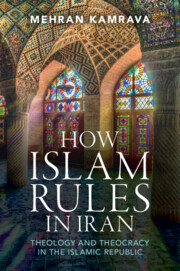Book contents
- How Islam Rules in Iran
- How Islam Rules in Iran
- Copyright page
- Contents
- Preface
- 1 Introduction
- 2 The Setting
- 3 A Question of Jurisprudence
- 4 Social Protection and Guidance
- 5 Rethinking the Islamic Republic
- 6 Theorizing Islamic Democracy
- 7 Legitimate Authority
- 8 Khameneism and the Absolute Velayat-e Faqih
- 9 Whither the Islamic Republic?
- Appendix Brief Biography of Some of the Figures Discussed
- Glossary
- Bibliography
- Index
8 - Khameneism and the Absolute Velayat-e Faqih
Published online by Cambridge University Press: 02 May 2024
- How Islam Rules in Iran
- How Islam Rules in Iran
- Copyright page
- Contents
- Preface
- 1 Introduction
- 2 The Setting
- 3 A Question of Jurisprudence
- 4 Social Protection and Guidance
- 5 Rethinking the Islamic Republic
- 6 Theorizing Islamic Democracy
- 7 Legitimate Authority
- 8 Khameneism and the Absolute Velayat-e Faqih
- 9 Whither the Islamic Republic?
- Appendix Brief Biography of Some of the Figures Discussed
- Glossary
- Bibliography
- Index
Summary
Ali Khamenei, a least likely leader on Khomeini’s death, capitalized on his years of political and organizational experience to outmaneuver and outfox friends and foes alike and to emerge as Iran’s paramount leader. Khamenei’s ascent was slow and by no means certain, with the leader having to take a back seat to the likes of Rafsanjani on the political front and to Montazeri in matters of jurisprudence. Steadily, however, with political assistance from the Revolutionary Guards and the Basij, and ideological support from Mesbah Yazdi and other ascendant figures within the Qom clerical establishment, Khamenei’s position was increasingly strengthened. Simultaneously, Khamenei’s traditionalist, conservative brand of Shia theology emerged as the formal ideology of the state. Starting with the second term of the Ahmadinejad presidency in 2009, “Khameneism” became politically and ideologically dominant in Iran. Today, whatever this Khameneism is meant to signify is far from uncontested. But its political, ideological, and jurisprudential dimensions rule over the country. The absolute velayat-e faqih, a position devised and first occupied by Khomeini, has found its full expression during Khamenei’s long tenure as Iran’s leader.
- Type
- Chapter
- Information
- How Islam Rules in IranTheology and Theocracy in the Islamic Republic, pp. 264 - 296Publisher: Cambridge University PressPrint publication year: 2024



